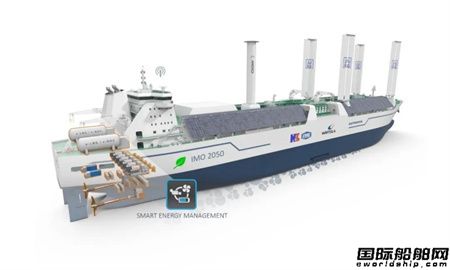
Current LocationïžHome - News - Industry

|
|||
| Publishedïž2021.09.16 News SourcesïžQingdao Gute Ship Supplies Co., Ltd. Viewsïž | |||
|
ABS joins hudong Zhonghua and Wartsila to develop IMO2050 carbon emission standard LNG carriers
The LNGC will be highly flexible and the ship's design will be optimized around a compact, modular and efficient hybrid electric propulsion system that will result in significant reductions in greenhouse gas emissions. It is also prepared to integrate new technologies effectively in the future to ensure compliance with CII. Patrick Ryan, SENIOR vice President of global Engineering and Technology at ABS, noted, "The decline in CII requirements each year means that ships need to take continuous steps to maintain and even upgrade their ratings throughout their service life to ensure compliance and viability. Advanced multi-physical field modeling and simulation techniques will ensure that the jointly developed ships have excellent CII after delivery and can be utilized as future carbon reduction technologies mature and continue to be met throughout their life cycle. ABS is a leader in offshore multi-physical field modeling and simulation applications, and we are excited about the potential of this technology to drive the shipping industry's carbon reduction goals and achieve the IMO 2050 goals." Of hudong zhonghua shipbuilding group, deputy chief engineer Mr Song Hui commented, "we are very glad to work closely with wartsila and ABS, the development has low greenhouse gas emissions, low operating costs of a new generation of LNG ship, we develop the new type using the most advanced hybrid solution, makes more fuel engine to run within the range of optimum efficiency all the time, And flexible power supply mode to adapt to various load requirements." Wartsila Systems Integration Solutions experts are working with the expert teams at ABS's Global Simulation centers and Global Sustainability Centers in Singapore, Houston and Athens, as well as hudong Zhonghua Shipbuilding's LNG ship design and development team, using advanced multi-physical field models, To evaluate the carbon intensity indicator (CII) performance of different designs and ship operation models using various carbon reduction technologies up to 2050. Stefan Nysjo, Vice President, Wartsila Marine Power Business, said, "In order to meet the AMBITIOUS IMO goal of reducing carbon intensity CII by at least 70% by 2050, shipowners are facing unprecedented challenges and extreme uncertainty when planning their ship assets. But what is clear is that such planning must begin now, and waiting is not a wise choice. Optimized ship design through hybrid electric propulsion systems will maintain high efficiency across all speed and load ranges and meet the needs of future ship operations in an unpredictable market." Nysjo added, "The modular hybrid electric propulsion system also lays the foundation for incorporating zero-carbon fuels and the application of new carbon-reducing and energy-saving technologies, which can be implemented during the new shipbuilding phase or as a retrofit option later on. We are honored that ABS and HUDong China have chosen Wartsila to participate in the development of this new LNGC design, where ABS's long experience in LNGC development and simulation and Hudong China's extensive experience in the design and construction of large LNGC will come into play." In April 2018, IMO adopted a preliminary strategy for reducing greenhouse gas emissions from ships, setting key targets including reducing annual greenhouse gas emissions from international shipping by at least half of 2008 levels by 2050, and working to eliminate greenhouse gas emissions and reduce the carbon intensity of international shipping as soon as possible this century. Strive to reduce average emissions from international shipping by at least 40% by 2030 and 70% by 2050. These measures combine technology and operational methods to improve the ship's energy efficiency. All ships must calculate their existing Ship Energy Efficiency Index (EEXI), and ships exceeding 5,000 gross tons will establish their annual operating Carbon Intensity Index (CII) and CII rating. In other words, ships will receive their energy efficiency rating -- A, B, C, D, E -- with A being the best. Currently, shipowners are facing unprecedented challenges and uncertainties as they plan their fleets to meet the International Maritime Organization's Carbon Intensity Indicator (CII) target of 70% carbon reduction by 2050. To be sure, shipowners must plan now to secure new shipbuilding designs for the future. By installing and optimizing ship designs around compact, electrified and hybrid propulsion systems, ship owners gain highly optimized and flexible assets. |
|||
| This Paper Is Divided Into 1 Page | |||
| Next:Shanchuan Heavy Industry delivered the fourth 85,000-ton bulk carrier leased by AVIC | |||
| Previous:Qingdao Shipyard built China's first self-navigating container ship for sea trial | |||








